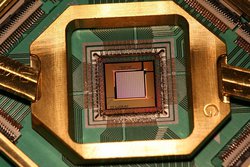
Sept. 27, 2016
By: Michael Feldman
Quantum computing pioneer D-Wave Systems has announced some details of a new 2000-qubit system it has developed. The processor that drives the system will contain twice the number of qubits that powers the current D-Wave 2X system, which was announced last year. The new hardware also includes additional control features that enables users to tune the quantum computations to arrive at a faster result and to explore the solution space more fully.
 1000-qubit processor. Image: D-Wave Systems.
1000-qubit processor. Image: D-Wave Systems.
D-Wave has been in the quantum computing business since 2011, when it sold its first machine to Lockheed Martin. Subsequent sales to NASA, Google, and Los Alamos National Lab provided additional credibility. Throughout its history, the company has come under fire for not actually delivering “true” quantum computing. The D-Wave hardware is based on quantum annealing, a technology that will not support the type of universal quantum computer sought by many.
Nevertheless, the company has demonstrated some interesting speed-ups on certain types of applications relative to classical computing systems and is hoping that the jump to 2000 qubits will improve those performance advantages substantially. According to D-Wave, doubling up on the qubit count has enabled up to a 1000-fold speed-up on some early tests. That will not only make some applications already developed for previous D-Wave machines run faster, but also make it feasible to tackle much more difficult problems.
Getting enough qubits to solve the types of optimization problems that quantum computing systems should excel at has been a challenge for D-Wave. Since computation time grows exponentially with problem size, the race to add more qubits has been a major focus at the company.
For the current 1097-qubit 2X machine, D-Wave has documented performance improvements of between 8x and 600x using classical solvers and executed as a single thread on a conventional CPU. Parallelizing the code across multiple CPU threads is likely to narrow that performance gap considerably, and employing other conventional processor technologies like GPUs or FPGAs might eliminate the advantage of the 2X system entirely.
But with a 2000-qubit machine, the performance advantage on some of these codes could get a large boost given the cumulative effect of more qubits. D-Wave has yet to release any new metrics, but those should be forthcoming as we get closer to the launch date. Although the press announcement didn’t specify a release date for the new hardware, the company is expected to ship systems with the new chip sometime in 2017.
